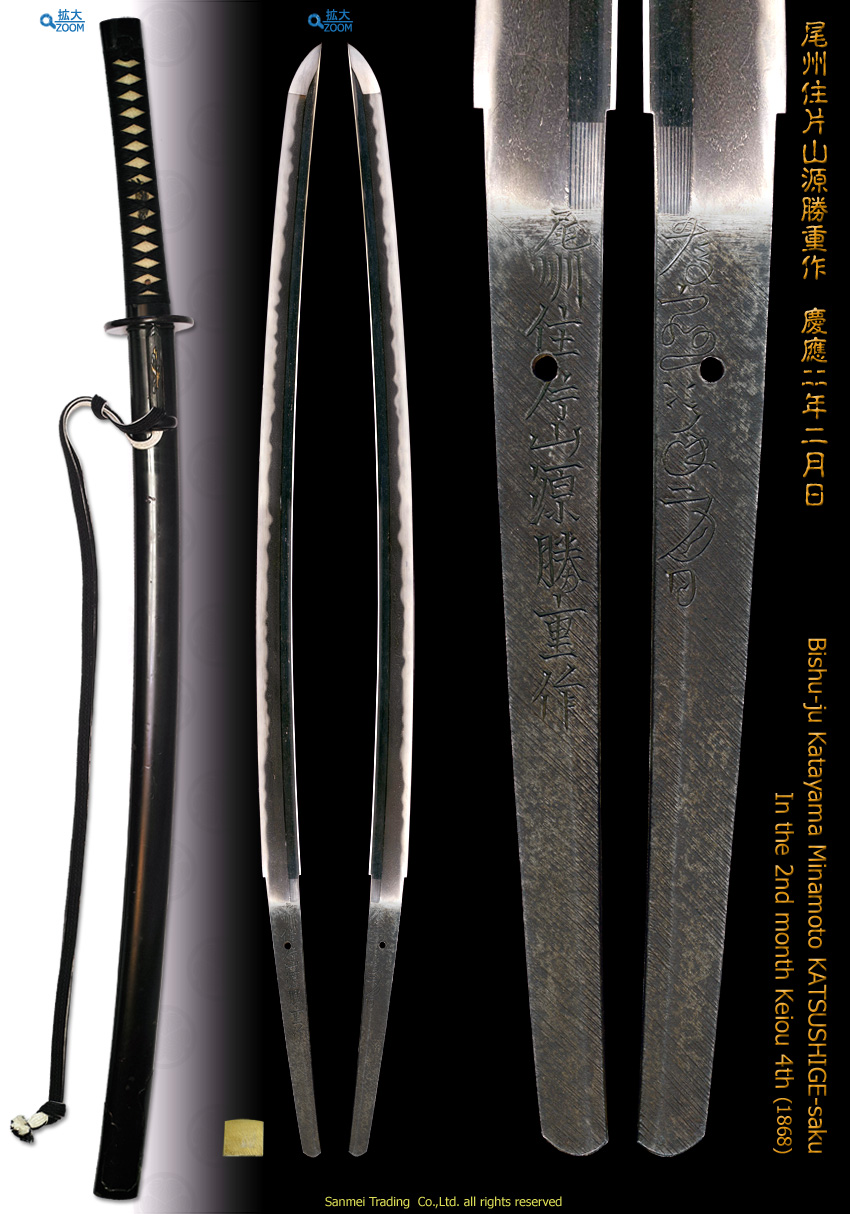In the 2 nd month Keiou 4 th
with) Kuro-Roiro lacquered scabbard Uchikatana Koshirae
Length of cutting edge 74.6cm Curvature 1.6cm Width of base 34.5mm Width of Yokote 25.2mm Thickness of base 8.2mm
Kitae(forging pattern) : The entire steel gives off bluish tendency. Kitae is conspicuous Itame hada generally with the indication of Mokume burl. Striking Masame straight ware appears on Shinogi-ji surface. Sparkling frosty Ji-nie is distributed in certain areas over the Hira-ji surface and gleaming Jet black luster of Chikei that comes from unique trait of fine steel with different carbon content appears and also glows as Kin-suji thick line of Nie or Sunagashi short lines into quenching Hamon area.
Hamon(tempering pattern) : Hamon state is "Nie-deki" that is rather on stronger side, Notare with undulating Gunome, small tassel-shape outline Choji-ha and some indication of Togari-ha. Some isolated Muneyaki appears along back ridge. Sparkling martensite particles of Nie accumulates deeply along quenching area where works with Inazuma and Kinsen/Sunagashi activity and the interior of temper is filled with frosty sparkling Nioi.
Boshi (tip): Almost in full of Ichimai boshi surging of flame so called KAEN then turns back deeply to join Muneyaki on ridge.
Nakago(tang) : The Nakago is original UBU. One Mekugi-ana retaining hole. "O-sujikai" with Kesho decorative filemarks. Back ridge of Nakago is a bit round contoured with "O-sujikai" filemarks. "Ha-agari Kurijiri" of single bevelled heel. The entire Nakago preserves an excellent taste of patina from 19th C. The large and deeply chiseled nie character Bishu-ju Katayama Minamoto KASTUSHIGE-saku 尾州住片山源勝重作 and the other side is inscribed with the date of year In the 2 nd month, Keiou 4 th (1868) 慶應二二年二月日.
The founder KATSUSHIGE 勝重 who belonged to Senji-school had appeared in Kuwana, Ise domain during Kanbun era (1661-). He moved to Seki-Kajimachi in a castle town Nagoya (now in Marunouchi 3-chome, Naka-ku, Nagoya) in his later age.
In later ages end of Edo period, the subject maker KATSUSHIGE 勝重 whose real name is KATAYAMA Hikoichirou 片山彦一郎 set his studio at Chita-gun.
The shape is magnificently brave and lively forged under Soushu-tradition from increasing demand from Samurai supporters of the doctrine of restoring the Emperor to get powered and expelling the barbarians.
This extra long katana is imressively heavy on hands to show brilliant hamon to have an great air of dignity expecting Meiji renovation.
An original koshirae set of mount deserves special mention and upgrade the dignity of this KATSUSHIGE 勝重 Katana.
with) Black Roiro lacquered scabbard Uchikatana Koshirae (click HERE for entire Koshirae in front/HERE for back side, clokc HERE for each fitting)
- Fuchi/Kashira, Kojiri and Tsuba : Shakudo polish ground, unsigned
- Menuki : Gentiana scabra design, Shakudo ground, Yobori carving, Iroe
- Wari-Kogai : Fern design, Shakudo Nanako-ji, Takabori, Iroe, unsigned
- Kozuka : God of thunder design, Shakudo Nanako-ji, Takabori, Iroe, unsigned
Tsuka : White rayskin, Black silk cord lozenge wrap
Silver ground gold plated Habaki collar, preserved in a Shirasaya plain wood mounting.
Good old polish/Condition scale: mint-excellent (using a scale of mint-excellent-very good-good-fair-poor).
reference data :
IWATA Atou, Owari Toukou fu, Nagoya city board of education, 1984




